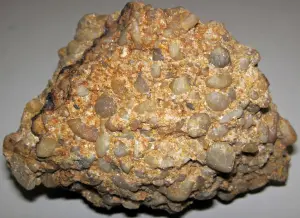Although looking similar, a conglomerate and a sedimentary breccia are not the same thing
A conglomerate is a type of rock that is made up of a mixture of different types of rocks, such as pebbles, cobbles, and boulders. These rocks are usually cemented together by a matrix of clay, sand, or other fine-grained material. The main difference between a conglomerate and a sedimentary breccia is the size and shape of the individual rocks that make up the rock.

In a conglomerate, the individual rocks are usually larger and more rounded. They are also typically more uniform in size and shape. This is because the rocks in a conglomerate have been transported by water or ice. It tends to smooth and round the edges of the rocks.
On the other hand, a sedimentary breccia is made up of smaller, more angular rocks. These rocks are typically jagged and irregular in shape. This is because the rocks in a breccia have been broken and then cemented together. The breaking of the rocks can occur due to a variety of factors, such as tectonic activity, erosion, or weathering.
Not only size and shape
Another key difference between these two types of rocks is the way that they are formed. Conglomerates are typically formed in areas where there is a lot of water or ice movement, such as rivers or glaciers. The rocks are transported and then deposited in a new location, where they are cemented together.
Sedimentary breccias, on the other hand, are typically formed in areas where there is a lot of tectonic activity. The rocks are broken by the movement of the earth’s crust, and then cemented together in the new location.
In summary, the main difference between a conglomerate and a sedimentary breccia is the size and shape of the individual rocks that make up the rock. Conglomerates are made up of larger, more rounded rocks, while breccias are made up of smaller, more angular rocks. Additionally, conglomerates are formed in areas where there is a lot of water or ice movement, while breccias are formed in areas where there is a lot of tectonic activity.






